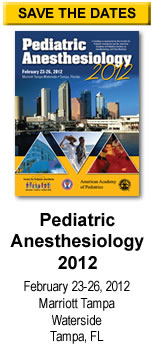SPA Reviews from Pediatric Anesthesiology 2011
The Society for Pediatric Anesthesia held its winter meeting from March 31st to April 3rd, 2011 in San Diego, California. The meeting was organized by Program Chair, Dr. Mary Ellen McCann, and included something for everyone who takes care of children in the perioperative environment.
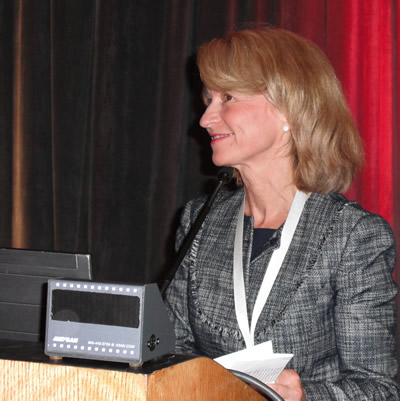
Program Chair Mary Ellen McCann, MD, MPH
The day prior to the SPA offered members and guests an opportunity to attend the CCAS Program (reviews found elsewhere in this newsletter), a Special Interest Group on Pain Medicine moderated by Drs. Rita Agarwal, Petra Meier-Haran and Rosalie Tassone, a SPA Leadership Skills Workshop, or an Advanced Ultrasound Guided Regional Anesthesia Workshop.
Friday, April 1st, 2011 was the first full day of sessions which was kicked off by early morning PBLDs. Once the audience assembled, Dr. McCann provided the Welcome and Outline of the Educational Program.
Neurotoxicity in the OR-Are We Harming our Patients’ Brains?
Reviewed by Allison Kinder Ross, MD
Duke University Medical Center
The first session was moderated by Dr. Randall Flick (Mayo Clinic, Rochester). It started with Dr. Sulpicio Soriano (Children’s Hospital, Boston) speaking on the Basic Science of Neurotoxicity. He reminded the audience that neuroapoptosis is a natural event in the brain for “pruning," however the acceleration of this process is what may result in abnormal neurodegeneration. Mechanisms of the neurotoxic effects of anesthetics include antagonism of the NMDA receptor. Effects are related to dose and length of exposure to anesthetic. Interestingly, low dose ketamine, xenon or dexmedetomidine may be somewhat protective against neuronal death.
Following the basic science discussion, Dr. Lena Sun (Columbia University) provided the audience with her talk, Update on the Clinical Evidence of Anesthetic Neurotoxicity. Dr. Sun reviewed the clinical trials that have been published recently, where the retrospective cohort studies suggested that early exposure to anesthetics may result in adverse neurodevelopmental outcome. She also presented a twin registry finding from the Netherlands that failed to show any adverse effects. What was clear was that additional work needs to be done as all studies to date are retrospective in nature and have many other confounding variables. The PANDA study was discussed and will hopefully help to answer the important question of whether exposure to anesthetics has long-term effects. Wrapping up the session was Dr. Adrian Bosenberg (Seattle Children’s) who gave alternatives to the use of general anesthesia for neonates. In particular, Dr. Bosenberg discussed the advantages of using regional anesthesia over general anesthesia and how this would be of benefit to the neonatal population by avoiding their potential deleterious effects to the developing brain.
Controversies Surrounding the Other Common Therapies in the OR
Reviewed by Catherine R. Bachman, MD
University of Chicago
The second session on Friday morning on controversies, moderated by Dr. Roland Brusseau (Children’s Hospital Boston), was very interesting in that they discussed long standing mainstays in anesthesia practice, and brought forth evidence that changes in our practice may be needed.
Dr. Julie J. Niezgoda (Cleveland Clinic), in a provocative and thought-provoking review, challenged our thinking concerning common beliefs and practices regarding the use of oxygen in her presentation on Oxygen and other Toxins. Beginning with an historical perspective on oxygen’s discovery and a review of basic biochemistry, she set the construct for her argument that “Oxygen is critical to our life, but our cells were never meant to be bathed in it." She discussed that increased concentrations of inhaled oxygen create oxygen radicals, which are very similar as those created in radiation toxicity. These free radicals can produce various deleterious effects. In 1988 Saugstad coined the phrase “oxygen free radical disease of the newborn." In 2001 a study looking at the practice of resuscitating full term neonates with 100% oxygen vs. room air revealed evidence of oxidative stress lasting at least 28 days in the 100% oxygen group. Multiple studies since have demonstrated evidence of oxidative stress with use of 100% oxygen, including elevated biochemical markers, increased risk of death in neonates, and increased incidence and severity of bronchopulmonary dysplasia. In rats, increased oxygen exposure has been associated with increased CNS apoptosis. She also discussed studies demonstrating that too much oxygen may increase the risk of cancer. One study reported that the risk of childhood cancer was increased if the child had been exposed to three minutes of 100% oxygen as a neonate in the delivery room. Julie’s presentation reviewed evidence that should make us question our common practices concerning oxygen, and raises more questions – what are the risks, who is most at risk, and how much risk?
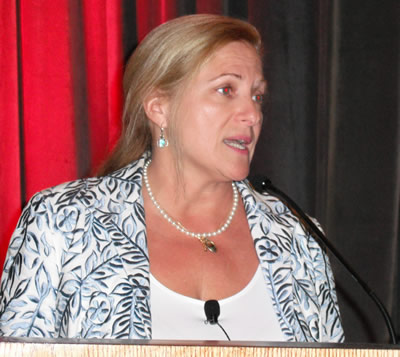
Julie J. Niezgoda, MD
Dr. Peggy McNaull (University of North Carolina) presented a challenge to another strongly held belief – that of the “third space” in her presentation The Myth of the Third Space. She began with an historical review of fluid therapy over the centuries. It was not until 1950 that the modern IV catheter for pediatric use was developed. The term “third space” was coined in 1961, and the concept of third space has significantly influenced fluid management in the perioperative period. Peggy argued that the classic “third space” has never been localized, and in fact does not exist. Rather fluid is shifted within the functional extracellular fluid compartment, from the intravascular space to the interstitial space. Peggy reviewed evidence that the perioperative use of hypotonic vs. isotonic intravenous solutions can increase the risk of hyponatremia and of perioperative complications such as cerebral edema and seizures. The amount of intravenous fluid administered to patients also affects complication rates. Studies comparing fluid restriction to more liberal regimens of IV fluid administration reveal that fluid restriction is associated with fewer perioperative complications, including pulmonary edema, wound infections, and pneumonia. Her conclusions were:
- Intravenous fluid therapy should be goal directed.
- Hypotonic intravenous therapy should be avoided in the postoperative pediatric patient.
- Postoperative patients on maintenance intravenous therapy should have frequent electrolyte analysis.
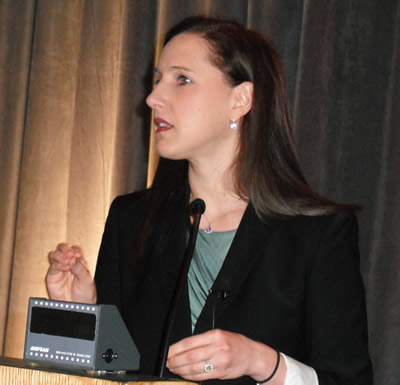
Peggy P. McNaull, MD
Health Care Reform: The impact on healthcare delivery
Reviewed by Cheryl K. Gooden, MD
Mount Sinai Medical Center, New York
The third morning session moderated by Dr. Nancy Glass (Texas Children’s Hospital, Houston, TX) provided an overview of the issues surrounding universal coverage and the future of health care reform. The first speaker Dr. Michael McManus (Children’s Hospital Boston) presented “Making it in Massachusetts: Universal Coverage and the Quest for Affordable Healthcare.” He provided us with some background on the positions of health care and insurance costs in Massachusetts dating back to 2005. At the same time, it was noted that healthcare was becoming more and more a concept of shared responsibility. Dr. McManus highlighted Acts of 2006, Chapter 58 that essentially mandated access to affordable and quality health care to all state residents. He reflected on the first five years of this universal coverage and overall lessons learned from the Massachusetts experience. For the most part, achieving access is easier than controlling cost. Dr. McManus concluded his presentation with the query – A National Solution? What we do know with certainty is that change is inevitable.
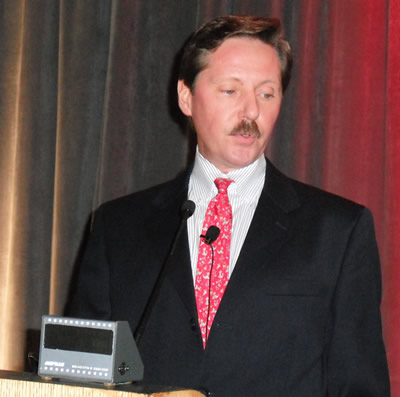
Michael L. McManus
Dr. Stan Stead (UC Davis) presented “Unfunded Federal Mandates.” Dr. Stead provided rather timely information on the affect of new federal mandates regulations on anesthesia economics, examined the timeline of new regulations, and management strategies in health care reform. He highlighted some of the features of the state high-risk pools, and most important is that persons who are denied insurance because of a pre-existing health condition will have coverage. In 2014, the federal health reform law will prohibit the denial of coverage. This law already exists with regards to children. Equally important are state health insurance exchanges that must be operational in 2014. These exchanges will provide the uninsured with the opportunity to purchase health insurance. Also to occur in 2014, Medicaid eligibility will include all persons under the age of 65 years with incomes up to 133 percent of the federal poverty level. Changes are imminent. There are many more changes ahead as we transition towards health care reform. The “take home message” is to be vigilant of the process of health care reform so as not to be left out.
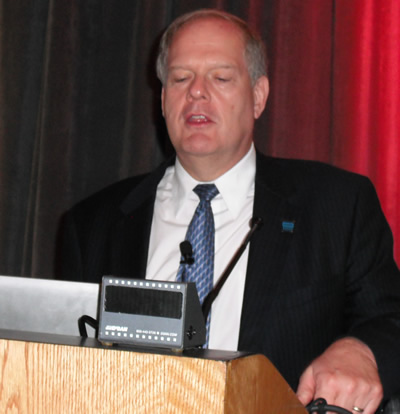
Stan Stead, MD, MBA
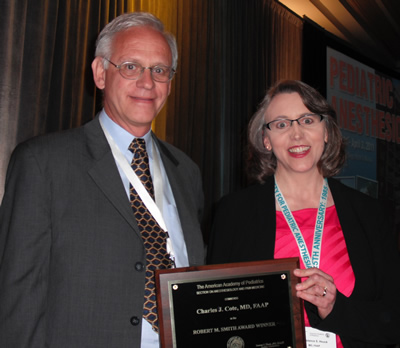
Constance S. Houck, MD presents the AAP Robert M. Smith Award
to Charles J. Coté, MD, FAAP
Saturday, April 2nd was the day for early morning PBLDs and morning core lectures followed by oral presentations, abstract awards, refresher courses and workshops.
Core Lectures-The Pediatric Patient with Endocrine Disorders
Reviewed by Constance Monitto, MD
Johns Hopkins Medical Center
On Saturday morning, Dr. Kirk Lalwani (Oregon Health and Science University) moderated the core lecture series on the pediatric patient with endocrine disorders. Dr. Zeev Kain, (University of California, Irvine) opened the session with a talk titled “Update on Stress Response to Surgery.” Dr. Kain began by reviewing for the audience early work on the stress response reported by Cuthbertson in 1932 and Moore in 1962. He differentiated stress responses by their timing, reporting that the acute stress response occurs during the first 48 hours after an insult, a time during which the body attempts to conserve energy, while the chronic response is notable for development of a hypermetabolic state. Interestingly, unlike adults and older children, neonates have been shown to become hypermetabolic on the first day after an insult. He reported that the metabolic response to injury can involve secretion of ACTH which plays a role in the resultant hypermetabolism. In addition, injury can induce an immunologic/inflammatory response that involves secretion of cytokines generating early increases in TNF-a and IL-6 levels, and subsequent elevation of IL-8 levels. Furthermore, increases in cytokines can also increase ACTH secretion. He next discussed factors that modulate the stress response, including age, the impact of chronic stress on immune function, surgical approach and severity, temperature maintenance, the use of regional anesthesia to block afferent inputs, administration of corticosteroids to impact pain and pulmonary function. Finally, he discussed how the anesthesiologist may modulate some of these factors and thereby impact long-term clinical outcome.
Pediatric endocrinologist Dr. Michael Gottschalk (Rady Children’s Hospital) reviewed the incidence, clinical presentation, treatment options, perioperative concerns, and long-term outcome associated with the management of craniopharyngiomas in children. He informed the audience that craniopharyngiomas are slow growing suprasellar tumors that can arise from remnants of the craniopharyngeal duct or Rathke’s pouch. The incidence of craniopharyngioma ranges between 0.5 and 2 per million. They account for 6 to 10% of all intracranial tumors of childhood, and occur most commonly between 5 and 14 years of age. The most common presentation involves headache, visual impairment, and endocrine abnormalities, including growth failure. Local extension of the tumor can cause problems involving memory, appetite perturbation, and emotional lability. Imaging (CT and/or MRI) is the best way to diagnose these tumors as it can be hard to diagnose hypopituitarism biochemically in part because of the confounding influence of normal diurnal variation in serum hormone levels. Dr. Gottschalk reported that initial treatment generally involves surgical resection with the operative approach dictated by the location and extent of the tumor. However, in general, craniopharyngiomas of childhood usually require a transcranial approach for removal. Perioperative management generally entails addressing postoperative hormonal deficiencies. Critical hormones that may be impacted include cortisol, thyroid hormone, and ADH. Because patients frequently receive dexamethasone around the time of surgery, decreases in cortisol are usually tolerated in the acute perioperative period. Similarly, decreases in thyroid hormone are generally well tolerated initially. However, diabetes insipidus caused by decreased secretion of ADH, will generally require management that must be based on assessment of the ongoing clinical picture, including urine output, and serum sodium levels. Because it can be difficult to totally resect craniopharyngiomas, some patients are treated with radiation therapy as well as surgery. However, Dr. Gottschalk reported that Winkfield and colleagues have recently published a study suggesting that long term outcomes are comparable between patients who are treated with surgery versus surgery and radiation therapy.
Endocrinologist Dr. Steven Waguespack (MD Anderson Cancer Center in Houston) gave a talk titled “Pediatric Pheochromocytoma and Paraganglioma: A Primer for the Anesthesiologist.” The objectives of Dr. Waguespack’s informative presentation were to review the pathophysiology, diagnosis, and perioperative management of pheochromocytomas (PHEOs) and paragangliomas (PGLs).
He informed the audience that, like the more commonly occurring neuroblastoma, PHEOs and PGLs arise from sympathoadrenal progenitor cells that are the precursors of adrenal medullary tissue. Because PHEOs and PGLs are derived from chromaffin cells, they can both synthesize catecholamines, and ultimately degrade catecholamines to vanillylmandelic acid (VMA) and homovanillic acid (HMA).
While PHEOs arise in the adrenal gland, he reported that when tumors present extra-adrenally they are classified as paragangliomas. Although these tumors are extremely rare, they occur more commonly in hypertensive children, and are frequently familial. Importantly, although <10% are malignant, the risk of malignancy is increased with extra-adrenal presentation. Presentation in children usually includes sustained hypertension and also often includes headache or visual disturbances, while the classic triad of paroxysmal sweating, palpitations, and headache is less common. Diagnosis is frequently made on the basis of plasma and/or 24-hour urine fractionated metanephrines. Catecholamines can be measured as well and may differentiate adrenergic (E+NE) from noradrenergic (NE) tumors.
Measurement of HVA and VMA are generally not useful except in the setting of neuroblastoma. Clonidine suppression and glucagon stimulation tests have been used in the past but are rarely needed to make the diagnosis. Imaging studies include CT or MRI, while functional studies, including MIBG and PET scanning, can be used to look for metastatic disease.
Dr. Waguespack updated the audience on the genetic syndromes and gene mutations that are presently known to be associated with PHEOs and PGLs. Mutations in the Von Hippel Lindau (VHL) gene that lead to VHL syndrome type 2 are associated with PHEO and MEN2. Mutations in the succinate dehydrogenase gene (SDHB) can be associated with familial paraganglioma syndromes, and mutations in this gene are associated with a 50% incidence of malignancy.
More recently, mutations in additional genes, including TMEM127 and SDHA (both tumor suppressor genes), KIF1B-b, and PHD2, have been shown to be associated with PHEO/PGL. Finally, he reviewed perioperative management. Treatment generally involves surgical excision of the tumor - either open adrenalectomy for removal of large PHEOs, or laparoscopic adrenalectomy via an anterior transperitoneal or posterior retroperitoneal approach in appropriate patients.
If disease is bilateral, cortical sparing is attempted when possible. Preoperative evaluation includes an assessment looking for underlying cardiomyopathy, though this is rare in children. Medical therapy in preparation for surgery involves treating hypertension, initially with alpha blockade and subsequent addition of beta blockers to treat compensatory tachycardia when necessary. Calcium channel blockers are also an option, as is metyrosine, which can be administered to block catecholamine synthesis, but he stated that this therapy is rarely required.
In general, antihypertensive medications are titrated to achieve an age-appropriate blood pressure as well as minimal orthostasis. Intraoperative concerns include the risk of intraoperative hypertensive crisis (most likely at induction and during tumor manipulation) which may require treatment with antihypertensives, antiarrhythmics if necessary, and, potentially, magnesium sulfate which acts by inhibiting catecholamine release and altering adrenergic receptor responses.
He reminded the audience that once the adrenal vein is ligated catecholamine levels can plummet causing hypotension that requires management with fluid resuscitation and vasopressor support. Postoperatively, both hypertension and hypotension can occur and needed to be treated appropriately. In addition, patients may also become hypoglycemic or develop adrenal insufficiency, both of which require appropriate therapy.
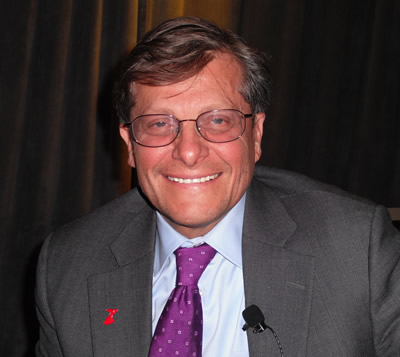
Michael F. Roizen, MD presented the keynote lecture on
Wellness and Physicians on Saturday, April 2
The AAP Ask the Experts Panel and lunch was moderated by Dr. Carolyn Bannister (Egleston Children’s, Atlanta) and focused on the Anesthetic Management for Patients with Endocrine Disease. Panelists were Drs. Daniel Roke, Akiko Ando, and Julie Williamson.
Sunday, April 3rd finished up the Program with the early morning PBLDs and another fun round of games, this time with a Family Feud Fest of Current Anesthetic Practices moderated by Drs. Myron Yaster and Frank McGowan. Panelists were the Lynn(e)s, East versus West, and included Drs. Lynn Martin, Linda Jo Mason, Anne Lynn, Lynn Ferrari, Lynda Means and Lynne Maxwell. The topics were truly controversial, included audience participation, and were entertaining as well as informative with regard to how different people manage a variety of clinical scenarios.
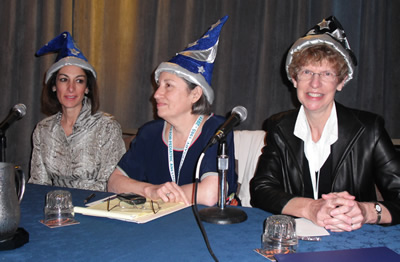
Drs. Lynn Ferrari, Lynn Maxwell and Lynda Means
during the Family Feud Fest.
The program’s final presentation was moderated by Dr. Lynne Maxwell (Children’s Hospital of Philadelphia) and included the journals that carry important articles in the specialty.
Editor’s Picks
Reviewed by Sean Flack, MD
Seattle Children’s Hospital
Dr. J. Lance Lichtor (University of Massachusetts) preceded his presentation of Anesthesiology’s best articles by introducing the journal’s new blog titled “page 2." He noted that four of the blog’s five contributors are pediatric anesthesiologists. The blog may be accessed via the journal’s website, http://page2anesthesiology.org/, as well as via twitter (@page2anesth).
The articles presented all explored the theme of neurotoxicity following neonatal exposure to anesthetic agents. The first study, (Arvind P et al. Anesthesiol 2011; 114:521-528), considered the effect of early gestational exposure to isoflurane in Sprague Dawley rats. Five rats and their embryos were anesthetized on gestational day 14, equivalent to a 2nd trimester exposure in humans. At eight weeks of age, the pups were subjected to behavioral testing, including a variety of mazes and familiar object recognition. These tests uncovered behavioral abnormalities, particularly with respect to acquisition of spatial working memory. Problems with this study included administration of 100% oxygen during the period of anesthesia, lack of proof for causation and the fact that only male rats were studied.
Istaphanous GK et al (Anesthesiol 2011; 114:578-87) compared the neuroapoptotic properties of equipotent anesthetic concentrations of desflurane, isoflurane or sevoflurane in neonatal mice. 89 male and female pups received a 6-hour exposure to one of the volatiles in 30% oxygen following which they were immediately euthanized. Histological evidence for apoptosis was found in all groups.
Finally, Hansen TG et al (Anesthesiol 2011; 114:1076-1085) studied academic performance in 2,689 adolescents that had undergone infant inguinal hernia repair. Data was obtained from the Danish demographic database and national hospital registry and the comparison group was a 5% sample of the normal population. The outcome measured was individual performance in a standardized 9th grade academic achievement test undertaken by all Danish children. Demographic findings worth mentioning included a preponderance of boys (89% versus 51%) in the study group as well as younger and less educated parents of the children that underwent surgery. Following linear regression modeling, average test scores did not differ between the two groups. Strengths of this study included large size while weaknesses included an ethnically homogenous population as well as an outdated anesthetic technique.
Dr. Peter Davis (University of Pittsburgh) presented two studies from Anesthesia and Analgesia. Patel A et al (Anesth Analg 2010; 111:1004-1010) studied the effect of dexmedetomidine infusion for analgesia and prevention of emergence agitation in children with obstructive sleep apnea syndrome undergoing tonsillectomy and adenoidectomy. Children aged 2-10 years received dexmedetomidine (2mg/kg bolus, 0.7mg/kg/hr infusion) or fentanyl (1mg/kg) and depth of anesthesia was maintained (BIS < 60) with sevoflurane. Postoperatively, children were evaluated for emergence agitation (Cole scale, PAED scale) and pain (OPS scale). Findings of this study included higher intraoperative rescue fentanyl requirements (36% versus 10%) and higher PACU morphine requirements (48% versus 17%) in the fentanyl group. Time to wakening and time to extubation were shorter in the dexmedetomidine group. Also, pain and emergence agitation scores were significantly better in the dexmedetomidine group. These findings suggest that dexmedetomidine may offer significant opioid sparing effects in a patient population vulnerable to adverse events following opioid administration. However, a few comments should be made: this was not a dose defining study and patients were not followed following discharge home. An important question remains whether non-surrogate markers such as length of hospital stay and ICU admission rates are affected by dexmedetomidine administration in this setting. Despite, or perhaps because of, its shortcomings, this study should serve as an inducement to further investigations exploring the role of dexmedetomidine in patients with OSA.
Asphyxia due to inhaled foreign body is the leading cause of accidental death in children aged < 4 years. Fidkowski CW et al (Anesth Analg 2010; 111:1016-1025) performed a literature review of 12,979 cases of tracheobronchial foreign bodies in children. The authors searched the English medical literature for studies with >100 patients aged 18 years or younger resulting in 30 papers containing a total of 12,979 children. Most children were aged 3 years or younger, boys more commonly than girls. 81% of foreign bodies were organic in nature (peanuts, seeds, etc) and most foreign bodies (88%) were located in the bronchi. Reported witnessing of an aspiration event was not shown to be particularly sensitive or specific in correctly diagnosing FB aspiration. Also, presenting symptoms were mostly unhelpful, with the exception of cyanosis, which was highly specific. Air trapping or atelectasis on CXR was not particularly sensitive. Radiologic evidence for mediastinal shift, however, was highly specific for foreign body aspiration. Fortunately, major complications such as cardiac or respiratory arrest were rare, but did occur. Virtual bronchoscopy by means of reformatted 3D CT scans is possible with the ability to image up to the 6th-9th bronchial divisions.
Dr. Charles Coté (Harvard University) presented on behalf of the journal Paediatric Anaesthesia. He reminded the audience of two theme issues: in 2010, the theme issue addressed the topic of TIVA, while the 2011 theme issue was devoted to developmental pharmacology. In particular, a review article titled "Developmental pharmacogenomics” (Neville KA et al. Paediatr Anaesth 2011; 21:255-65) was termed a "must read." Other highlighted papers in this issue include: "Towards evidence-based pharmacotherapy in children," "Designing simple PK-PD studies in children" and "Tips and traps analyzing pediatric PK data."
An article by the ADARPEF group (Ecoffey C et al. Paediatr Anaesth 2010; 20:1061-1069) demonstrated the safety of regional anesthesia in children, despite the fact that most children are anesthetized prior to the performance of regional anesthesia. A retrospective study of complications during rapid sequence induction in children by Gencorelli FJ et al (Paediatr Anaesth 2010; 20:421-444) observed that children <20kg are at increased risk for severe desaturations. The effect of age on the dose of remifentanil for tracheal intubation in infants and children was examined by Hume Smith H et al (Paediatr Anaesth 2010; 20:19-27) using a sequential up/down method. They concluded that the ED50 for ideal intubating conditions in children is 3-3.5mg/kg.
Recommended review articles included “Fundamentals of neuronal apoptosis relevant to pediatric anesthesia” (Blaylock M et al. Paediatr Anaesth 2010; 20:383-395) described as a nice general discussion of this important topic. Roelofse JA authored an article titled “The evolution of ketamine applications in children” (Paediatr Anaesth 2010; 20:240-243) that was recommended as a quality review of a “wonderfully versatile and often underutilized drug." Bertolizio G et al (Paediatr Anaesth 2011; 21:347-358) provided a review that explains why hypothermia for cerebral insults may not work in an article titled “Brain temperature: heat production, elimination and clinical relevance."
In a study of perioperative complications in children with pulmonary hypertension by Williams G et al, the use of ketamine was not associated with increased complications (Paediatr Anaesth 2010; 20:28-37). Rabbitts JA et al (Paediatr Anaesth 2010; 20: 1078-1083) demonstrated that perioperative opioid requirements were decreased in hypoxic children living at altitude. Dr. Coté speculated whether this finding might be related to OSA and opioid sensitivity.
Dr. Coté concluded the session by praising an article authored by anesthesiologists from two university hospitals in Benin, West Africa (Paediatr Anaesth 2010; 20:741-747). The article described a mortality rate of 62% following cardiac arrest under anesthesia. Risk factors included age <1 year, ASA status and emergency procedures. Monitoring was not regularly used at either of these institutions. It is hoped that the courageous publication of these findings will lead to improved governmental support for our colleagues working in such difficult circumstances.
Following the Editor’s Picks, the Winter Meeting of the Society for Pediatric Anesthesia was officially concluded with an educational summary.
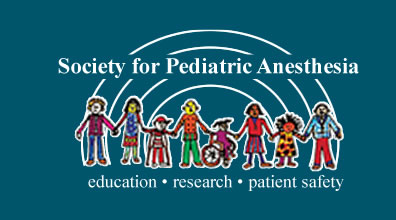
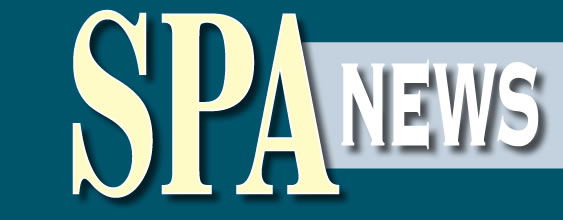
 Click
Click 